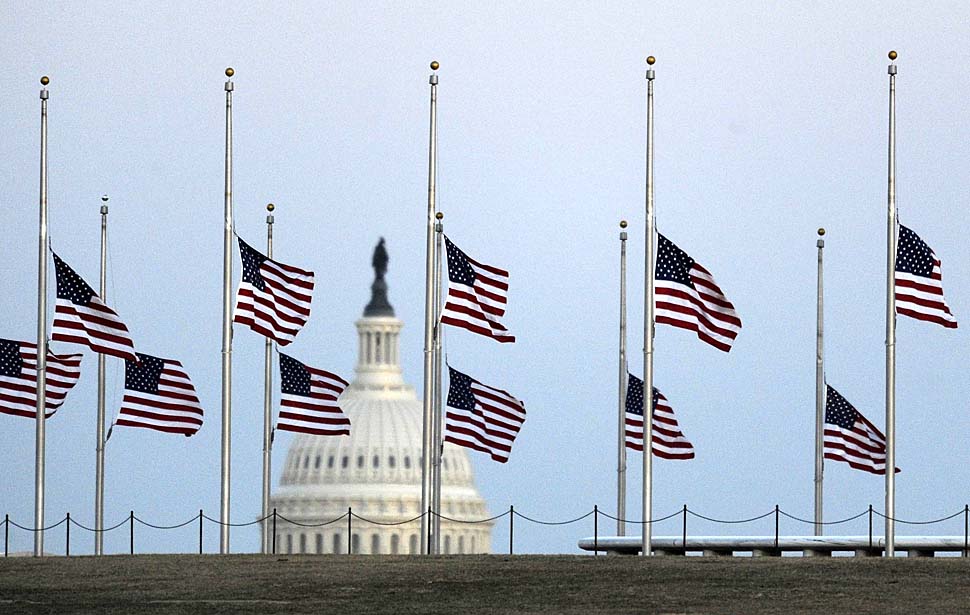



FACTS
ABOUT FLYING THE FLAG
![]()




![]()
With the recent revival of
patriotism, many more people are flying flags. Here are some tips on the proper
way to display flags, followed by information on the proper disposal of flags.
The federal flag code says the universal custom is to display the US flag from
sunrise to sunset on buildings and stationary flagstaffs in the open. However,
when a patriotic effect is desired, the flag may be displayed 24-hours a day if
properly illuminated during the hours of darkness. Also, the US flag should not
be displayed when the weather is inclement, except when an all-weather flag is
displayed.
Half Staff
On special days, the flag may be flown
at half-staff. Check here for latest notices for flags in the US: http://halfstaff.org
and for flags in Illinois:
http://il.halfstaff.org/ On Memorial Day, it is flown at half-staff until noon and then
raised.
-- Do not let the flag touch the ground.
-- Do not fly flag upside down unless there is an emergency.
-- Do not carry the flag flat, or carry things in it.
-- Do not use the flag as clothing.
-- Do not store the flag where it can get dirty.
-- Do not use it as a cover.
-- Do not fasten it or tie it back. Always allow it to fall free.
-- Do not draw on, or otherwise mark the flag.


For additional flag information, check out http://www.ushistory.org/betsy/faq.htm .
For local help in purchasing flags and grave markers, contact All Flags, 630 351-5481.
![]()
Oh, say, can you see, by the dawn's early light,
What so proudly we hail'd at the twilight's last gleaming?
Whose broad stripes and bright stars, thro' the perilous fight,
O'er the ramparts we watch'd, were so gallantly streaming?
And the rockets' red glare, the bombs bursting in air,
Gave proof thro' the night that our flag was still there.
O say, does that star-spangled banner yet wave
O'er the land of the free and the home of the brave?

On the shore dimly seen thro' the mists of the deep,
Where the foe's haughty host in dread silence reposes,
What is that which the breeze, o'er the towering steep,
As it fitfully blows, half conceals, half discloses?
Now it catches the gleam of the morning's first beam,
In full glory reflected, now shines on the stream:
'T is the star-spangled banner: O, long may it wave
O'er the land of the free and the home of the brave!
And where is that band who so vauntingly swore
That the havoc of war and the battle's confusion
A home and a country should leave us no more?
Their blood has wash'd out their foul footsteps' pollution.
No refuge could save the hireling and slave
From the terror of flight or the gloom of the grave:
And the star-spangled banner in triumph doth wave
O'er the land of the free and the home of the brave.
O, thus be it ever when freemen shall stand,
Between their lov'd homes and the war's desolation;
Blest with vict'ry and peace, may the heav'n-rescued land
Praise the Pow'r that hath made and preserv'd us as a nation!
Then conquer we must, when our cause. it is just,
And this be our motto: "In God is our trust"
And the star-spangled banner in triumph shall wave
O'er the land of the free and the home of the brave!
![]()
![]()





Other Flags and Order of Precedence for Flag Display

Order of precedence for service flags:











![]()
The reason our Governor gives for the flag outside the Bloomingdale Library to be flying half-mast is posted on the bulletin board in the Library’s foyer.

George Washington’s Liberty Key:
Mount Vernon's Bastille Key --
the Mystery and Magic of its Body, Mind, and Soul